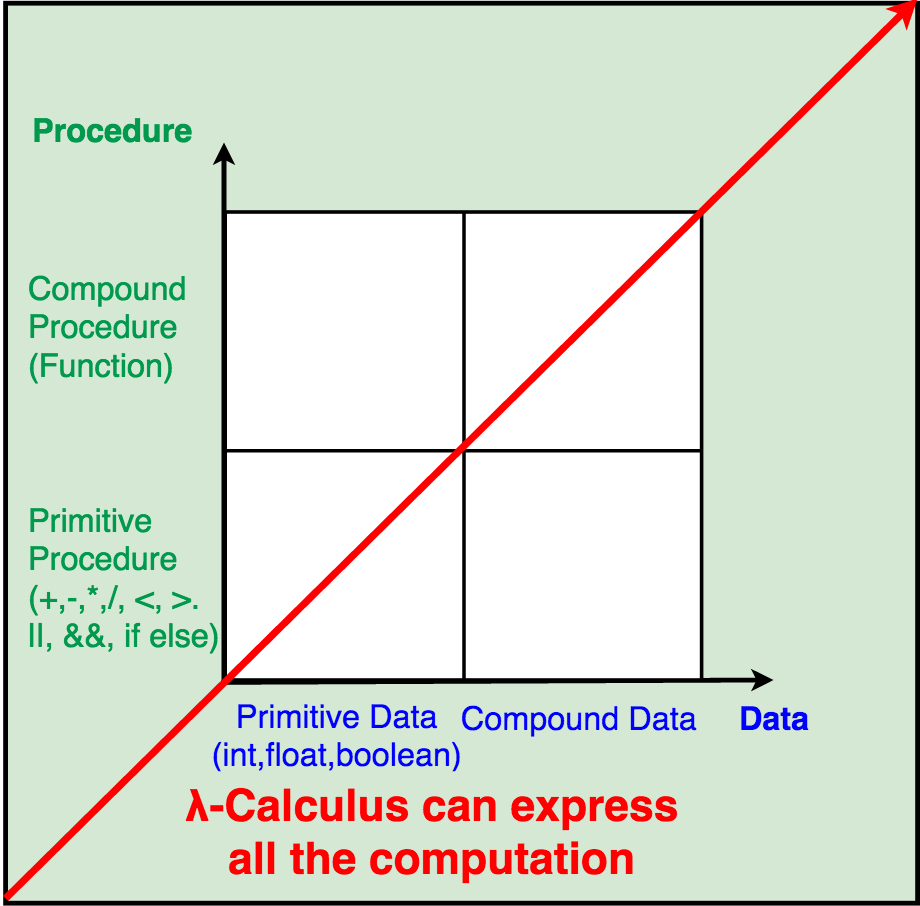目录
1. Abstraction With Data
在前两篇文章中,我们在λ-Calculus的定义下,了解了Primitive Procedure(+,-,*,/, <, >. ||, &&, if else)以及在此基础上组合出来的Compound Procedure,即函数(包括一阶和高阶)。Compound Procedure提升了Procedure的抽象级别,增加了编程的模块化,扩展了函数式语言的表达能力。而同时,从Data的角度来看,我们之前所使用的数据都是Primitive Data(int,float,boolean等),能否将Primitive Data抽象成Compound Data(即用c语言里的结构体来理解,只有数据,没有函数),从而从数据角度提高函数式语言的表达能力呢?
Procedure Abstraction: separate the way the procedure would be used from the details of how the procedure would be implemented in terms of primitive procedures;
Data Abstraction: separate the way the data would be used from the details of how the data would be implemented in terms of primitive datas;
Constructor:the interface between use and implementation。
2. Rational例子
接下来我们来看一个Compound Data的具体例子,有理数。
有理数是所有可以被表示成两个整数的商的数。它有一个分子和一个分母。我们还定义了用函数对有理数进行操作,比如求和,求差,求最大值等。需要注意的是这些函数是定义在Rational 类型的外面的,而Rationl里面只有数据(分子和分母)。函数gcd是用来求最大公约数的。
1
2
3
4
5
6
7
8
9
10
11
12
13
14
15
16
17
18
19
20
21
22
23
24
25
26
27
28
29
30
31
32
33
34
35
36
37
38
39
40
41
42
object Main extends App {
//the compound data is only composed of data
class Rational(x:Int,y:Int){
require(y !=0,"demoninator must be non-zero")
val numer = x/gcd(x,y)
val denomi= y/gcd(x,y)
private def gcd(a:Int, b:Int):Int = if(b==0) a else gcd(b,a%b)
}
// some compound procedure is defined outside "Rational" data
def toString(r: Rational) = r.numer + "/" + r.denomi
def makeRationl(x: Int) = new Rational(x, 1)
def neg(r: Rational) = new Rational(-r.numer, r.denomi)
def add(r1: Rational, r2: Rational): Rational = {
new Rational(r1.numer * r2.denomi + r1.denomi * r2.numer, r1.denomi * r2.denomi)
}
def sub(r1: Rational, r2: Rational): Rational = add(r1, neg(r2))
def less(r1: Rational, r2: Rational): Boolean = r1.numer * r2.denomi - r1.denomi * r2.numer < 0
def max(r1: Rational, r2: Rational) = if (less(r1, r2)) r2 else r1
//the compound procedure is used to react to the compound data
val r1:Rational = new Rational(4,5)
val r2:Rational = new Rational(3,4)
//for compound data, the interface between usage and implementation is "new" constructor
val r3 = add(r1,r2)
println(toString(r3))
val r4 = sub(r1,r2)
println(toString(r4))
val r5 = max(r1,r2)
println(toString(r5))
}
这个例子很好的诠释了Compound Data,即基础型数据类型组合起来的新的数据类型,c语言里的结构体就是Compound Data。
3. Assignment
这次作业我们先看二叉堆用函数式如何实现。
1
2
3
4
5
6
7
8
9
10
11
12
13
14
15
16
17
18
19
20
21
22
23
24
25
26
27
28
29
30
31
32
33
34
object Insets extends App{
val t1 = new NonEmpty(4, new Empty, new Empty)
val t2 = t1.incl(3)
println(t1)
println(t2)
}
abstract class Inset{
def contains(x:Int):Boolean
def incl(x:Int):Inset
}
class Empty extends Inset{
def contains(x:Int):Boolean = false
def incl(x:Int):Inset = new NonEmpty(x, new Empty, new Empty)
override def toString():String = "."
}
class NonEmpty(elem:Int, left:Inset, right: Inset) extends Inset{
def contains(x:Int):Boolean = {
if(x < elem) left.contains(x)
else if (x > elem) right.contains(x)
else true
}
def incl(x:Int):Inset = {
if(x < elem) new NonEmpty(elem, left.incl(x), right)
else if(x > elem) new NonEmpty(x, left, right.incl(x))
else this
}
override def toString():String = "{" + left + elem + right + "}"
}
这里比较tricky的地方是如何理解union操作,递归何时终止呢?

每一次递归,都会减少一个elem到incl(elem)操作,因此递归最后会到Empty,也就是退出条件。显然,按照这样的思路,我们可以有好几种实现,left和right交换是一样的,但是left和right先union还是left或right先union other却有着本质的不同。我们来比较一下

其中Sn是一个有n个元素的Inset,u表示union操作。表格里的数字是union调用的次数,我们可以看到它只和Sn中的n有关,因此我们用T(N)表示SnuSM所需要的时间,T(0) = 1,也就是Empty的union操作。
对于第一种实现((LuR)uO)inclE,假设L包含M个元素,则R包含N-M-1个元素,LuR返回N-1个元素。所以T(AuO) = T(N) = T(M) + T(N-1) + 1,即LuR需要T(M)的时间,然后返回N-1的Inset继续。最好的情况是M为0,则T(N) ~ O(N);最坏的情况是 M = N-M-1,T(N) ~ O(2N)。
对于第二种实现Lu(Ru(OinclE)),T(AuO) = T(N) = T(M) + T(N-M-1) + 1。则T(N) ~ O(N)。
因此第二种情况要优于第一种情况,课程里的union的实现效率其实是非常低的。所以在作业中要用第二种实现。除此之外,assignment中剩下的就是细节问题了,具体实现见这里。
4. λ-Calculus总结
到现在为止,我们都还没有涉及OOP的概念,在non-OOP的前提下,我们实现了如下关于函数和数据类型的概念:
- λ-Calculus can express all the calculation。It contains function and vaiable(data);
- Primitive Procedure(+,-,*,/, <, >. ||, &&, if else) can be used to build Compound Procedure(Function)。Function in λ-Calculus can only take one argument,then how λ-Calculus can be claimed to be universal if it cannot present multi-argument function? The answer is of course it can, only by using Currying(nested high order function);
- Primitive Data(int,float,boolean)can be used to build Compound Data;
- the Compound Procedure and Compound Data both improve the modularity,conceptual level and expressive ability of λ-Calculus.
那么现在的问题是,以上1-4点都是在non-OOP下的实现,如何将λ-Calculus(Functional programming)和OOP结合起来呢?Compound Data用OOP结合method实现Class是很容易想到呢,那么另外三种该如何实现呢(Compound Data,Primitive Procedure,Compound Procedure)?
合上书本,有一个问题一直萦绕在脑中,目前为止,我们处在一个怎样的编程世界中呢?到底我们现在在哪里?下面这张二维图或许是一个参考答案:
